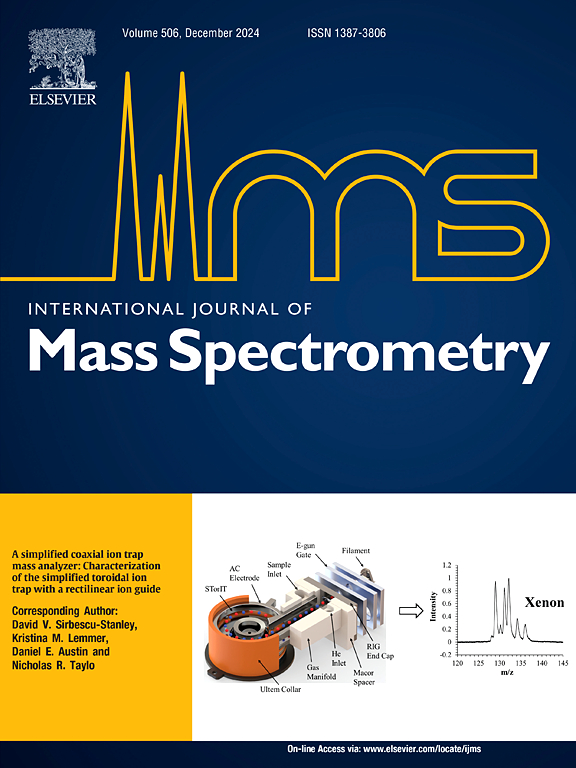Infrared multiple photon dissociation spectroscopy of protonated amino acid clusters with non-interacting side chains in the gas phase
IF 1.7
3区 化学
Q3 PHYSICS, ATOMIC, MOLECULAR & CHEMICAL
引用次数: 0
Abstract
We report on gas-phase aggregation and structural characteristics of protonated amino acid clusters investigated by ion mobility spectrometry-mass spectrometry (IMS-MS) and infrared multiple photon dissociation (IRMPD) spectroscopy. Amino acids, including valine, isoleucine, phenylalanine, tyrosine, and tryptophan, were studied to understand the formation and stabilization mechanisms of their clusters. The mass spectra reveal the formation of clusters, primarily as zwitterionic assemblies stabilized by extensive hydrogen-bond networks between protonated amine and deprotonated carboxylate groups. IRMPD spectra in the 1000–1900 cm⁻1 region highlight distinctive vibrational features, indicating the presence of zwitterionic structures for clusters larger than octamers. Theoretical calculations support these findings, revealing a transition from non-zwitterionic to zwitterionic with increasing cluster size. Additionally, the charge state distribution analysis indicates that the cluster charge states correlate with their accessible surface area, supporting the applicability of the charged residue model (CRM) for their formation. These results offer valuable insights into the forces governing amino acid cluster assembly and highlight their potential as nanoscale models for studying biomolecular interactions.

具有非相互作用侧链的质子化氨基酸团簇的红外多光子解离光谱
利用离子迁移谱-质谱(IMS-MS)和红外多光子解离(IRMPD)光谱研究了质子化氨基酸团簇的气相聚集和结构特征。研究了氨基酸,包括缬氨酸、异亮氨酸、苯丙氨酸、酪氨酸和色氨酸,以了解它们簇的形成和稳定机制。质谱揭示了簇的形成,主要是由质子化胺和去质子化羧酸基团之间广泛的氢键网络稳定的两性离子组合。在1000-1900 cm - 1区域的IRMPD光谱突出了独特的振动特征,表明在大于八聚体的簇中存在两性离子结构。理论计算支持这些发现,揭示了从非两性离子到两性离子的转变随着团簇大小的增加。此外,电荷态分布分析表明,簇状电荷态与其可达表面积相关,支持了电荷残馀模型(CRM)对簇状电荷形成的适用性。这些结果提供了对控制氨基酸团簇组装的力的有价值的见解,并突出了它们作为研究生物分子相互作用的纳米尺度模型的潜力。
本文章由计算机程序翻译,如有差异,请以英文原文为准。
求助全文
约1分钟内获得全文
求助全文
来源期刊
CiteScore
3.60
自引率
5.60%
发文量
145
审稿时长
71 days
期刊介绍:
The journal invites papers that advance the field of mass spectrometry by exploring fundamental aspects of ion processes using both the experimental and theoretical approaches, developing new instrumentation and experimental strategies for chemical analysis using mass spectrometry, developing new computational strategies for data interpretation and integration, reporting new applications of mass spectrometry and hyphenated techniques in biology, chemistry, geology, and physics.
Papers, in which standard mass spectrometry techniques are used for analysis will not be considered.
IJMS publishes full-length articles, short communications, reviews, and feature articles including young scientist features.

 求助内容:
求助内容: 应助结果提醒方式:
应助结果提醒方式:


